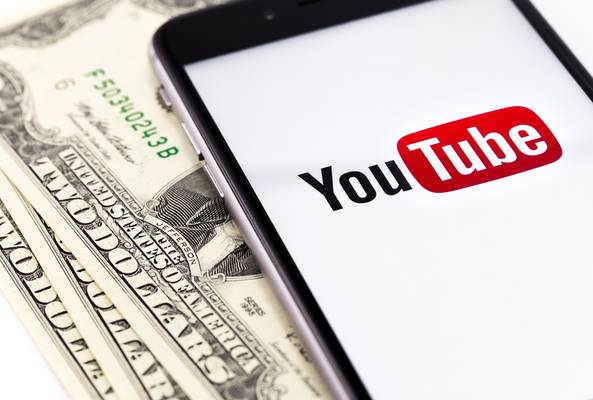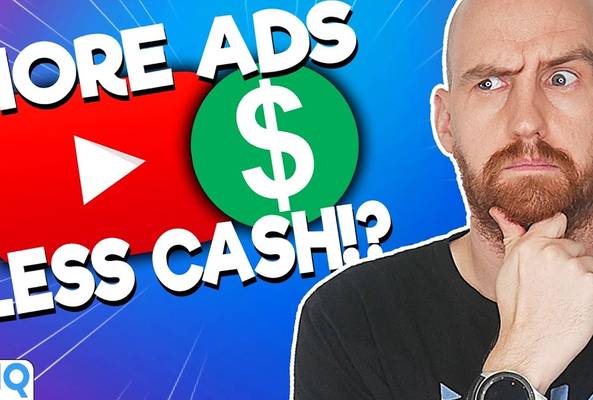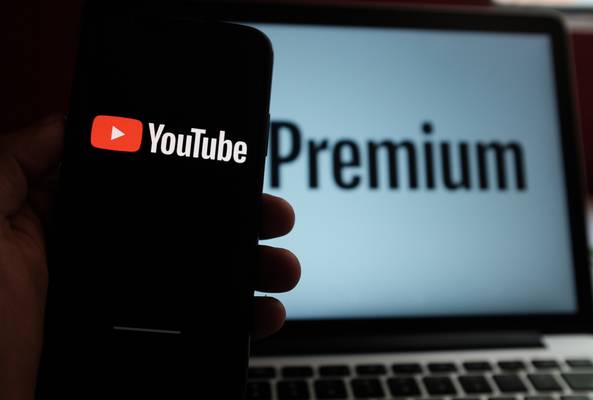Lydia Sweatt is a writer, bookworm, and bass guitar enthusiast. When she goes outside, a bicycle goes with her.
14 Ways to Avoid YouTube Demonetization

JUMP TO SECTION:
- What Does ‘Demonetized’ Mean on YouTube?
- How to Tell If a YouTube Video Is Demonetized
- 1. Post a Diverse Collection of Videos
- 2. Add Something Valuable to Repurposed Content
- 3. Don’t Be Spammy, Deceptive, or Participate In Scams
- 4. Leave Hate Speech Out of Your Videos
- 5. Minimize Your Use of Profanity
- 6. Don’t Show Dangerous or Illegal Activities
- 7. Avoid Posting Sexually Explicit Content
- 8. Use Royalty-Free Music From the YouTube Library
- 9. Treat Everyone on YouTube with Respect; Don’t Cyberbully
- 10. Don’t Make Shocking or Disturbing Videos
- 11. Avoid Showing Graphic Violence In Your Videos
- 12. Make Videos That Are Safe For Young Viewers
- 13. Stay Away From Controversial Issues
- 14. Avoid Sensitive Events and Topics
- YouTube Demonetization: Why Intent and Video Context Matter
Why do YouTube videos get demonetized? It’s a valid question, especially when someone takes the time to film, edit, and upload a video. Most creators try their best to make positive, original content for viewers around the world. What are they doing wrong in terms of making money and staying monetized on YouTube?
Read More: Google AdSense 101 - How to Benefit from Ad Revenue on YouTube
Most of the time, it's a lack of information. Creators know the basics of YouTube's rules, but they don't always know the fine details. And overall, people are just ready to record!

YouTube has several policies, and they all matter:
- YouTube community guidelines: A set of rules to ensure everyone’s safety on YouTube
- Advertiser-friendly content guidelines: An explanation of which videos are suitable for advertisers
- AdSense program policies: A set of terms and conditions for placing ads on YouTube videos
- YouTube terms of service: A set of terms and conditions for how viewers and creators operate on YouTube
Violating any of the four could lead to demonetization. Here's how to avoid that outcome.
What Does ‘Demonetized’ Mean on YouTube?
If YouTube demonetized a video, that means it restricted all ads from appearing. That includes every type of ad available to creators: display ads, overlay ads, sponsored cards, and skippable and non-skippable video ads. You won’t earn Google AdSense revenue for demonetized content.
Turning off ads is just one form of demonetization. YouTube also has the power to:
- Suspend monetization on all your accounts.
- Permanently disable monetization. This option bars you from all the money-making features: Google AdSense, Super Chats and Stickers, Super Thanks, merchandise shelves, Channel Memberships, and YouTube Premium revenue. It’s like being kicked out of the YouTube Partner Program.
How to Tell If a YouTube Video Is Demonetized
After uploading a video, you can see its monetization status in less than an hour. It takes a while because YouTube is making sure the video is suitable for ads.
In the YouTube Studio, there are seven monetization icons. Each one tells you the status of a video’s earning power.

- Checking: YouTube is checking your video for ad suitability.
- On: Monetization is on, and your video is eligible for most ads.
- Sharing: Monetization is on for a song cover, but a music publisher claimed the revenue.
- Escrow: Monetization is on, but YouTube is still determining who will get paid.
- Limited: Monetization is on, but ads are limited.
- Ineligible: You turned on monetization for the video, but YouTube won’t show ads.
- Off: You turned off monetization for the video.
A red icon means your video is demonetized, as shown below.

How to Check a Video’s Monetization Status:
- Log into YouTube and click your profile icon in the top right corner. Select YouTube Studio from the menu.
- Click Content in the left navigation menu.
- Find the video in question using the search bar at the top of the page.
- Next to your video, look for the monetization column. You’ll see one of the seven icons (shown above) indicating your video’s status.
Videos that aren't advertiser-friendly won’t earn much revenue. Here are 14 ways to avoid demonetization on YouTube.
1. Post a Diverse Collection of Videos
Have you read the AdSense program policies? One of the requirements for monetizing your content is to avoid being repetitious. That means you shouldn't post videos with no recognizable differences on your channel. Your content needs a healthy dose of variety, from the audio tracks you use to the topics you cover.
That doesn’t mean you can’t explore one topic in depth. You can create similar videos as long as the bulk of each one is different. Take a look at the vidIQ YouTube channel, for example. We share tips for gaining 1,000 subscribers all the time. But the advice changes as we discover new methods, which means we’re always talking about something new within the context of gaining subscribers.
Overall, make sure your content isn’t:
- Mass-produced
- Overly templated
- Programmatically generated
2. Add Something Valuable to Repurposed Content
Using another creator’s intellectual property, such as songs, video clips, and images, could lead to one or more copyright claims on your channel. You’ll get these alerts when your video contains media that doesn’t belong to you. Copyright claims aren’t the end of the world, but YouTube might demonetize the video(s) in question or only give you partial revenue.
Read More: Can I Still Monetize My YouTube Channel If I have a Copyright Claim?
Total demonetization happens when you reuse someone’s content without adding something new or transformative. If you’re posting a reaction video, for example, add some commentary that brings a fresh perspective to the original event, opinion, or narrative.
Need more examples? YouTube says it's OK to monetize reused content when:
- You’re using brief clips for a critical review.
- You’re adding original commentary to an event (movies, sporting events, etc.).
- You’re adding an original storyline to edited footage from other creators.
Your best bet, of course, is to use your own content. But at the same time, YouTube understands that there are thousands of reaction channels out there. And guess what? Lots of creators are making money with that format.
3. Don’t Be Spammy, Deceptive, or Participate In Scams
YouTube wants every viewer to have a positive experience. And no user can do that while being tricked or misled by deceptive videos and comments. If you’re on the platform for the wrong reasons – like running scams and leading people to shady websites – YouTube might demonetize your content.
To stay on YouTube’s good side, don’t:
- Repeatedly post content about making fast cash.
- Lead viewers to websites with harmful software (viruses, information theft, etc.)
- Use misleading thumbnails, video descriptions, and titles to “trick” viewer into clicking.
- Promote “get rich quick” content or pyramid schemes.
- Sell engagement metrics, like views, comments, and subscribers. That includes Sub4Sub, a type of spam where creators ask people to subscribe to their channels.
- Post repetitive comments across YouTube.
- Post comments to gather information from viewers or drive them off of YouTube.
- Live stream content that doesn’t belong to you.
An Example of YouTube Spam
Check out the image below to see an example of comment spam. Notice how the circled comment is impersonating the owner of the video, finance creator Graham Stephan. If you look closely, you can tell that “Replied_by Graham Stephan” is a bogus account.

This user is trying to drive people away from YouTube. Practices like this will get you demonetized.
Read more about spam, deception, and scams on YouTube’s support page.
4. Leave Hate Speech Out of Your Videos
YouTube doesn’t tolerate hate speech of any kind. If you want to successfully monetize your videos, don't say (or type) harmful, offensive things. YouTube will demonetize your content if you're inciting violence or hate against specific groups.
Avoiding hate speech is easy. Think of all the ways people discriminate against others, and simply avoid saying those things in your videos. The most egregious hate speech revolves around age, sexual orientation, gender, race, disabilities, religion, immigration status, and veteran status.
Here are some examples of what you shouldn’t say, according to YouTube:

5. Minimize Your Use of Profanity
Are there certain “demonetized words” on YouTube? Is it possible to say the wrong thing and lose all your ad revenue?
YouTube won’t demonetize a video for containing words like “hell” or “damn.” That’s considered light profanity, and most people aren’t offended by those terms. It’s the vulgar words that will get you into trouble, like repeatedly dropping F-bombs or constantly saying “b*tch.”
Read More: Can You Swear on YouTube and Still Make Money?
Here is a list of words that lead to demonetization:
- C*nt
- Fa**ot
- Ni**er
- Other hateful slurs
Even when misspelled, adding these words to any element of a video (titles, thumbnails, etc.) is against the rules.
Our advice? Minimize the profanity in your videos. It's an easy way to get full monetization.
6. Don’t Show Dangerous or Illegal Activities
Want to make sure YouTube doesn’t demonetize your video? Avoid showing clips or images of bodily harm, gruesome injuries, and death. These themes are disturbing to viewers and scare advertisers away.
One example of dangerous content is Logan Paul’s 2017 “suicide forest” video. This was a huge scandal. Paul uploaded a YouTube video showing a dead body, and people around the world were deeply disturbed. He later shared a video of himself tasering dead rats. Eventually, YouTube temporarily demonetized his channel.
Posting illegal activities is a bad idea too. You’ll have a better chance of monetizing your videos if you don't show:
- Drugs (including tobacco products)
- Firearms
- Internet hacking
- Other criminal/questionable activities
The main thing to remember is that glorifying dangerous acts results in demonetization or worse. If you can expect certain injury or death from an activity, it’s not suitable for YouTube.
7. Avoid Posting Sexually Explicit Content
YouTube will demonetize any video that gratifies sex. This type of content focuses on nudity, sex scenes, and pornography. If that’s the creator’s intent – indulging in sexual scenes – the next step is a no-brainer for YouTube. There will be no ads on the video, zero AdSense revenue, and (possibly) a channel termination.
Clothed or unclothed, YouTube states that showing genitals, breasts, or buttocks in an indulgent way violates its monetization policies. Also, sexual fetishes of any kind and in various formats (video, text, images, audio) are not allowed.
Read more about nudity and sexual content on YouTube’s support page.
8. Use Royalty-Free Music From the YouTube Library
Music copyright is a deep subject on YouTube. But for the purpose of monetizing videos, you only need to know two things:
- Never use someone’s music without their written permission.
- Sometimes you need permission from all parties: songwriters, artists who created the melodies, record labels, etc.
Sounds complicated, right? You can skip all of that by using music from the YouTube library (shown below). The tracks are royalty-free, and you won’t get copyright claims or strikes.
Read More: How to Get Royalty-Free Music For Your YouTube Videos

9. Treat Everyone on YouTube with Respect; Don’t Cyberbully
Cyberbullying is an ever-present issue online. In fact, four in 10 Americans have experienced some form of unacceptable online behavior. Name-calling and threats are two of the most common. On YouTube, this is considered harassment and leads to demonetization.
No matter what happens on YouTube, don’t:
- Say racial slurs in your videos or write them as comments.
- Threaten anyone on YouTube, even if you’re bluffing.
- Post any piece of content to shame a minor.
10. Don’t Make Shocking or Disturbing Videos
For this tip, we’re not talking about plot twists and unexpected endings. Shocking content is simply hard to watch. These are videos that create a bad experience for viewers, and advertisers are less likely to support them.
According to YouTube, these shocking videos won’t earn revenue:
- Gory visuals of body parts, bodily fluids, or waste
- Raw footage of medical procedures, such as unedited birth videos
- Disturbing or gruesome injuries
- Wild animal preparation for eating or slaughter
11. Avoid Showing Graphic Violence In Your Videos
YouTube will demonetize videos with gory, gruesome visuals. That typically happens when the video has no context outside of brutal violence, even if you're showing a video game.

Don't make videos where these themes are the focal point:
- General violence that displays blood, guts, and gore (animal or human)
- Gaming clips edited to show gory violence
- War footage that includes shooting, explosions, bombings, injuries, and death
- Dead bodies and amputations
- Any form of animal abuse
- Police brutality
- Violence in sports
12. Make Videos That Are Safe For Young Viewers
Child safety is paramount on YouTube. Lots of kids watch videos on the main app (and not the YouTube Kids app), even though they're technically supposed to wait until they're 13.

Keep those young viewers in mind as make videos. Don't show:
- Sexually explicit content featuring minors.
- Dangerous activities that cause bodily harm to minors.
- Misleading family content that shows violence and sexual themes.
- Emotionally distressing content that shows parental abuse and coercion of minors.
- Cyberbullying and harassment of minors.
13. Stay Away From Controversial Issues
What YouTube considers to be controversial is not what most people think of when they hear the term. We aren’t talking about political debates or unpopular opinions here. YouTube defines controversy as “topics that may be unsettling” and “the result of human tragedy.”
Under that definition, a controversial video could show:
- Suicide
- Self-harm
- Eating disorders
- Sexual harassment
- Sexual abuse
- Domestic abuse
- Child abuse
- Pedophilia
YouTube will demonetize any video glorifying these topics, even if that happens in the title or thumbnail.
14. Avoid Sensitive Events and Topics
A sensitive event is something that took place recently and caused widespread suffering. These could be natural disasters that took dozens of lives, as well as terrorist attacks and war footage. As you can imagine, videos focusing on death and despair aren’t pleasant to watch. YouTube has no incentive to monetize such content, and you should avoid making these kinds of videos.
That doesn’t mean briefly mentioning a war, such as the War of 1812, will get you demonetized. How you reference it is what matters. If you’re focusing on the violence of it all and showing clips of how people died, you won’t earn revenue.
YouTube Demonetization: Why Intent and Video Context Matter
Your intentions for posting a video can save you from getting demonetized. Why? YouTube knows that few creators want to disturb viewers. Most people are on YouTube to inform, educate, or entertain.
Measuring Video Intent and Context
Here’s what YouTube looks for when measuring a creator’s intentions:
- Is the video meant to educate, like a documentary?
- Is the video meant to inform, like a news update?
- Or, is the video meant to disturb viewers/steal content from another creator?
An Example of Positive Creator Intent
Here’s an example. Let’s say you filmed a documentary about police brutality in the U.S. From the 1960s to the present, you explain how police brutality affects millions of people worldwide.
According to YouTube, showing police violence is not ideal. But adding that footage in your documentary is OK. The intent is to educate viewers – not glorify police violence. YouTube might “restrict” ads on the video, but there’s a good chance it won’t be demonetized.
Avoiding demonetization on YouTube isn’t hard. Just be mindful of the advertising guidelines and steer clear of disturbing topics.
Once you’re a pro at monetization, go the extra mile. Learn the seven factors that determine your AdSense revenue.


